Sewage pipe: uses, regulatory requirements, alternatives
What is it - a sewer pipe? Why is it needed? Are there any regulatory documents governing its structure? In what cases, and how can you manage without a fan’s right? Let's figure it out.
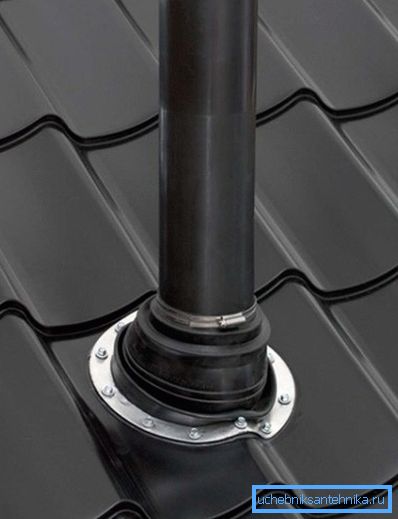
What it is
The sewer pipe is a section of the sewer system that serves not for the movement of drains, but for ventilation. Simply put, the pipe connects the sewer with the atmosphere.
Why do you need it?
There are two reasons.
- As in any other vertical pipe, there is a thrust in the sewer riser. The increase in pressure in the upper part of the domestic sewage system quite naturally leads to the fact that air begins to penetrate into the living rooms through unsealed joints. This air does not smell like roses.
Note: any sanitary device is equipped with a water valve. Through the release of a sink or shower air will not pass; However, the joints of the knee of the siphon and the sewer comb (internal waste water system) are not always sealed.

- When volley dumping (simultaneous flushing in two toilets on the riser, draining water from several baths, etc.) often there is a situation when the riser is full. Before the flow of water creates an air front with excess pressure; this air is emitted through the audits of the basement sewage of an apartment building or through the sewer of a sewer septic tank, cesspit, etc. But behind a mass of water moving downwards, a vacuum is created, which sucks the water out of the siphons, disrupting the operation of the water gates. The sound of a smacking toilet or sink by itself does not give the owner joy; when he foreshadows a wave of aromas - doubly unpleasant.
Both problems are successfully solved by a simple jumper between the upper point of the waste system and the atmosphere. The resulting odor causes odors to leave the house through a sewer riser; at volley dumping the air is sucked through it.
Regulations
In the current regulatory documentation, the arrangement of the funnel pipes is affected at least twice.
SNiP 2.04.01-85
According to paragraph 17.18 of SNiP 2.04.01-85, household or industrial sewage must be ventilated. Ventilation is through risers; their exhaust part is discharged through the ventilation shaft or through the roof. What should be the height of the riser?
| Starting point | Height |
| Flat roof unexploited | 30 cm |
| Pitched roof | 50 cm |
| Operated roof | 300 cm |
| Bleed ventilation shaft | 10 cm |
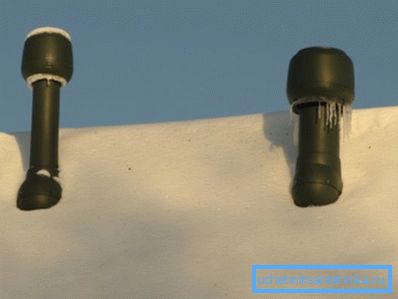
The minimum distance from the exhaust part of the riser to the nearest opening balcony or window is 4 meters. With what the instruction is connected - I think, it is not necessary to explain.
SP 40-107-2003
The code of construction rules SP 40-107-2003 in paragraph 4.8 separately specifies the case of the exploited roof. According to him, the exhaust part of the riser should really be equal to at least three meters; however, instead of equipment, you can simply combine four or more risers within a technical floor or attic.
Author's comment: in this case, with a salvo discharge in one or two of the risers, the others will indeed fulfill the role of a funnel for them. However, one cannot get away from the thrust created in the risers: the slightest breach of tightness at any joint - and smells will penetrate into the rooms of the upper floor.
rules
How exactly should the fan pipes be installed?
- Transitions of diameter (first of all - its lowering in the exhaust part of the pipe) are undesirable. When reducing the diameter from 110 to 50 mm, the throughput of the riser decreases by about 5 times; it may not be enough to compensate for the drop in air pressure.
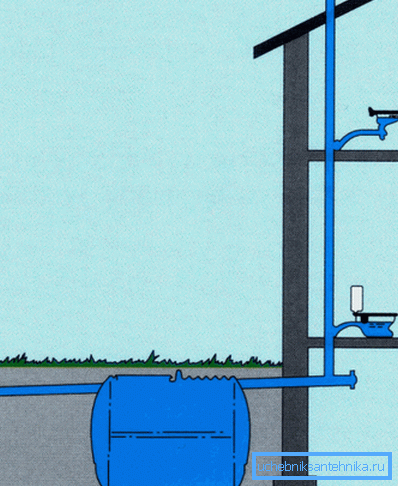
- Horizontal sections of pipe are laid with the same slope as the sewage system - 2 cm per linear meter. The slope will prevent the formation of water and air traffic jams.
- Sewer risers opening to the attic room are a bad idea. The matter is not only in smells: wet evaporation will worsen the insulation, soaking the insulation with dampness, and cause the truss system to rot.
- It is better to provide a fan stand with a deflector (aka a fungus or an umbrella). Thanks to the deflector, rainwater and garbage will not get into the riser; in windy weather, he at the same time increases the draft in the pipe, thereby making the ventilation more efficient. The price of an umbrella for a 110-mm pipe is from 120 to 200 rubles.
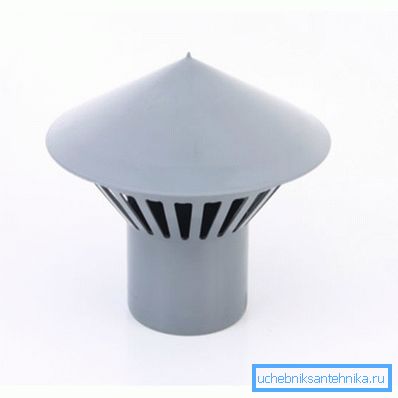
Exceptions
Is it possible to do without ventilation of the sewer system?
Here are the standard recommendations:
- Design and construction of houses without funnels is allowed only if it is a one- or two-story structure.
- At the same time in the house should be no more than one toilet and one bath.
And here is a list of cases in which even with a low number of floors, fan pipes are necessary.
- If the toilet and bath are separated on different floors.
- If the sewage system is laid with a pipe with a diameter of less than 100 millimeters (to be honest, in order to connect a toilet to this pipe, you need to have serious developmental deviations).
- If the house is built pool.

- If the local sewage treatment plant used for waste disposal is hermetic (a typical example is biological deep cleaning stations).
A special case
Residents of the upper floors often completely dismantle the sewer riser above the tee. Strictly speaking, this cannot be done: any change in the configuration of engineering communications should occur with the blessing of housing and utilities workers, which, of course, they will never give. However, the fact remains: repair in the toilet is sometimes accompanied by the removal of unused, from the point of view of the apartment owner, the pipe.
What to do if this operation has already led to quite predictable results - a stable smell of sewage in all apartments of the upper floors along the riser?
The simplest solution to the problem is a sewer drain valve. What it is? Constructive solutions can be different, so we describe not the mechanism of work, but the functionality of the device.
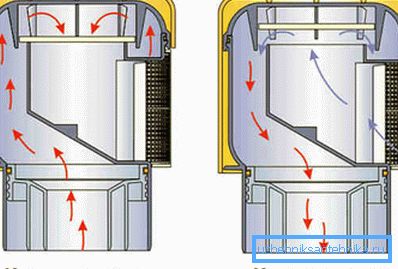
In short, it is a device that lets air only in one direction. In normal mode, in the upper part of the riser due to overpressure is present; however, the sewage valve does not allow saturated air with odors and moisture to enter the room. The vacuum created in the riser at a salvo discharge will cause the valve to open and suck in air.
It is useful: the valve (vacuum) valves are produced in two sizes - 110 and 50 mm. The latter are used for individual devices and for kitchen drain pipes in some houses of old projects.
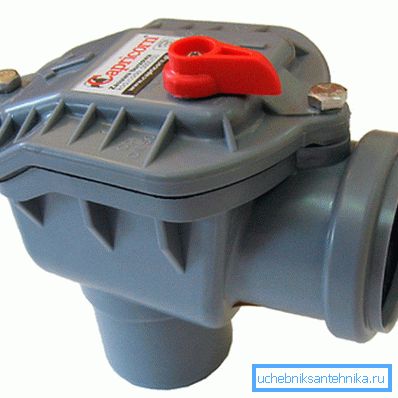
Note: a vacuum valve is not a panacea. Smells in the apartments on the riser will not be only with complete sealing of the entire connection. So, all connections of siphons and straps with pipes are necessarily supplied with cuffs.
Tips
The author, based on his experience, will allow himself to add a few comments to the standard recommendations.
The house with two toilets and baths - one bathroom on each floor - functioned perfectly for a year without a fan outlet. Smells were not observed. Strictly synchronous flush two toilet bowls - an infrequent event; Bathtub or shower with modern drain gratings with a fairly small capacity, the more sewage will not overflow.
When designing the location of the fan outlet, you should definitely take into account the prevailing wind direction. Smells can extend to a distance where more than 4 meters prescribed in SNiP 2.04.01-85.
You should not do the exhaust part of the riser is significantly longer than required by regulatory documents.
The longer the pipe, the less likely it is to be heated along the entire length of the moist and warm air rising from the house. And on the cold walls, it will inevitably freeze ice, gradually reducing the clearance to zero. In apartment buildings, a significant part of the winter complaints of residents is precisely the smell of sewage that has appeared due to ice traffic jams.
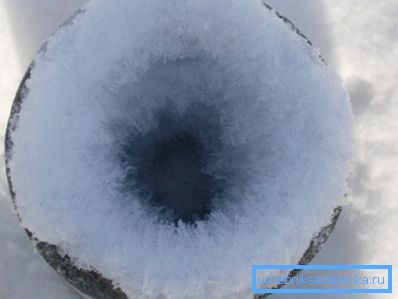
In a private house, when installing sewage systems with their own hands, a fan outlet can be released not only through the roof, but also through any of the gables. This will significantly simplify its waterproofing.
Conclusion
We hope that our recommendations will help the reader in designing or upgrading their own home sewage system. As always, the video in this article contains additional thematic materials. Successes!